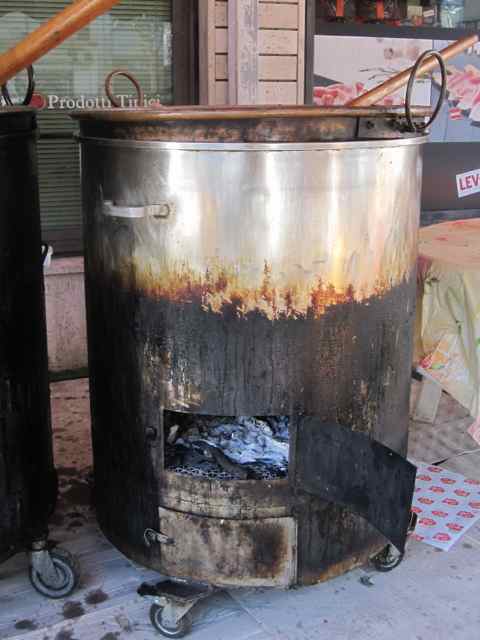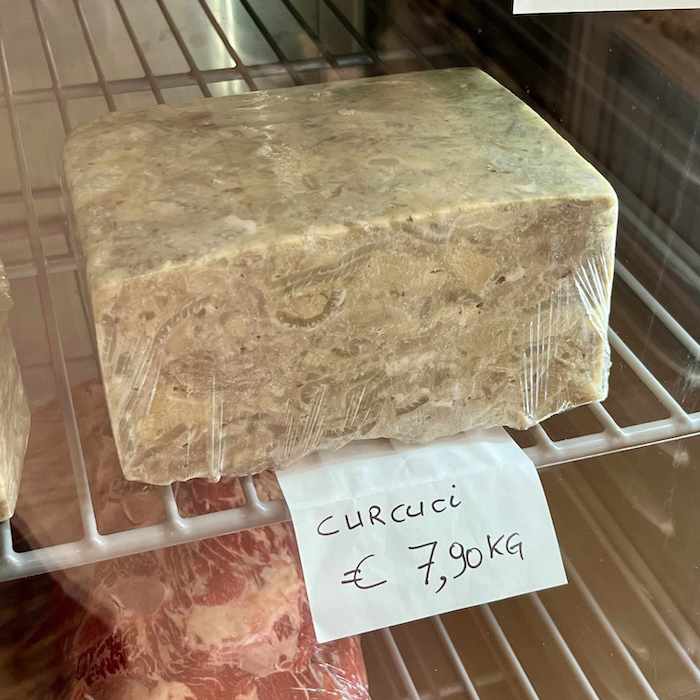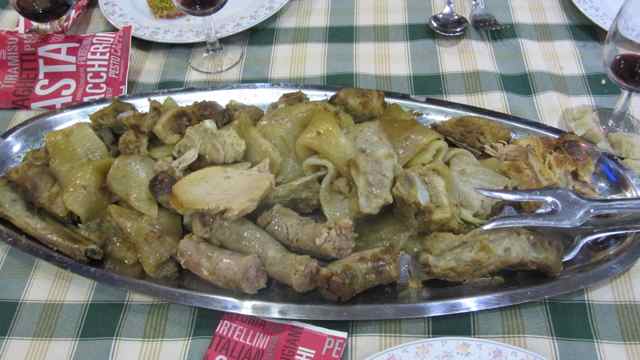INVITATION TO A PIG BOIL
My introduction to le frittole came early in my time in Calabria when I was invited to a student’s house in the country to participate in the experience. I must say that I was impressed with the master of ceremonies and his wife. They were just regular people—a civil servant and schoolteacher—who as far as I was concerned, had impressive countrified skills.
A friend and professional had apparently assisted with the killing and butchering of the pig, but these everyday Calabrians seemed completely at home with cooking it all up in a big caldron, making salami and sausage, and generally taking care of the whole schmear, so to speak. Of course, by the time I arrived, all that was left was to set the table and partake in the celebration.
TRADITION
It was all quite rustic, which seemed to be an integral part of the experience—a getting in touch with tradition. We ate in an unfinished basement that was set up with a wood-burning oven and curing area. My wool slacks were just a little too clean and tailored for the surroundings.
Years ago, most families would have been lucky to raise just one pig, to be ceremoniously killed and eaten in various forms throughout the year. There are still countless Italian expressions from the entire length of the peninsula attesting to the historical importance of the pig, many highlighting the concept that the entire animal was consumed in one way or another. For example:
Del maiale niente va perduto. (Nothing of the pig is lost.)
Del maiale non si butta via nulla. (Nothing of the pig is thrown away.)
The cold months are the most popular for a pig slaughter. Christmas and New Years holidays provide an excellent excuse, and the period of Mardi Gras, or Carnevale in Italian, gives the last chance to enjoy meat for a while. In Reggio, the pig boil is also featured for the Festival of the Madonna that is celebrated with processions in September and November.
LE FRITTOLE
So what does “frittole” mean? Wikipedia lists four options: an imaginary Tuscan town in a 1984 film of Roberto Begnini, a Venetian donut (variation of frittelle), a veal-based street food from Palermo (also frittola and frittula), and finally a pork dish typical of Reggio Calabria (frittuli in Reggio dialect). Italian is complicated, but clearly, I’m dealing with the latter, pork cooked in its own fat.

Le Frittole
The preparation involves a large caldron. In Reggio, butcher shops set up the oversized stainless steel-covered copper containers on the sidewalks in front of their stores. I’ve been told the charcoal-burning type is the best. The process begins in the wee hours of the morning, long before the crack of dawn, but perhaps not quite as early as the average baker starts his day.

Frittole Cauldron
The first step is to melt the fat. Then, the animal parts that require a longer cooking time go into the caldron—the feet, the snout and the ears, for instance. At this point, I have been told that a little water is added, the specific amount depending on the particular beast on hand. Some say, however, that the pig should only simmer in its pure fat. Whichever the method, the concoction bubbles slowly for many hours, a minimum of six, but longer is better—7, 8 or 10, such that even the cartilage and other lesser-prized parts become edible. Components requiring less cooking time are added later in the process, with salt being the only seasoning.

Shoveling in the charcoal
While the pancetta (bacon), guanciale (jowl) and other elements of the pig used to make sausages and salami are set aside after the sectioning and don’t make up part of the boil, the frittole isn’t composed only of “inferior” parts and cuts. Ribs and leg meat all go into the pot. The mixture is frequently stirred and elastic netting is used to keep the meat and bones together—practicality outweighing tradition in this case. And not wasting the heat of the simmering liquid, sausage are sometimes cooked in the liquid.
PORK RIND 101
I knew what le frittole looked like, and I was quite familiar with the taste of the fatty pork dish. For some reason, however, I didn’t put two and two together that the soft, shiny, opaque, fatty, slightly gummy matter that featured so prominently was the skin. Perhaps if I had consumed more cracklin’ in my life, I wouldn’t have confused it for some sort of fat, although this moderately squishy substance didn’t have much in common with the packaged pork rinds I’d sampled. Completely different textures, the variations on a theme seemed to share only the pig’s fatty richness.
When “le frittole” are served up on platters, there’s always a healthy proportion of the soft rind. Likewise, when a helpful native assists a newbie in the filling of his plate…and there goes another piece of the rind, slipping off the fork of the accommodating host. For me, a little goes a long way.
LA MACELLERIA – THE BUTCHER SHOP
When purchasing le frittole from a butcher shop in town, reserving your favorite cut of meat is recommended, especially if you plan on arriving anywhere near the lunch hour. The caldrons may be full and bubbling, assorted pig parts bobbing on the surface, butchers constantly stirring it all around bringing up pieces in other shapes and sizes, but the reality is that those legs and ribs may have all been spoken for and your lunch will consist of those smaller jetsam and flotsam the vendor must chase after with a fork.
The butchers do aim to please and a combination of an enormous wooden spoon with a giant sieved ladle and small serving fork will usually result in an ample portion of meat with your skin and other more adventurous parts of the pig’s anatomy.
After all of the floating contents have been scooped out, the remaining fat along with the scraps that fall to the bottom of the pot are conserved in blocks and often eaten with eggs. It’s called curcùci in Reggio and is similar to what the Neapolitans call ciccioli.
THE MEAL
As for their consumption, le frittole can be eaten as a dish in itself with some bread and a glass of red wine, or as a simple sandwich. In order to cut the fattiness, a light salad or vegetables preserved in vinegar often accompany the dish. In the winter, oranges in season finish the meal.
I suppose a manual laborer could eat a lunch of this sort and carry on his work for the rest of the day, but for me, after eating le frittole, I‘m in need of a pisolino (nap).
A FINAL PIG EXPRESSION
U porcu è a muntagna e a caddara bugghi. (dialect)
Il maiale è in montagna e la caldaia bolle. (Italian)
The pig’s in the mountain and the caldron is boiling.
Shut off the flame! The pig ought to be here by now! Either it isn’t happening or it probably won’t happen.
In the Province of Reggio Calabria, however, rest assured, that cow has come home. The caldrons are bubbling and the pigs are in them. The tradition of le frittole carries on.
Read more about Calabria’s culture and traditions in Calabria: The Other Italy, my nonfiction book that explores daily life, culture, history, the arts, food, society and tourism of the fascinating region in the toe of the Italian boot. Available in paperback and e-book versions. Would you like to visit Calabria? Check out the itineraries of my small-group Calabria tours.
Interested in more Calabrian specialties? Check out these food posts: The Bergamot: Calabria’s Incredible Citrus, The Precious Diamante Citron, Calabrian Eateries: Trattoria La Collinetta in Martone, Morzello of Catanzaro and Mammola and Mushrooms.
Connect on social media: “Like” Calabria: The Other Italy’s Facebook page, follow me on Karen’s Instagram and Karen’s Twitter for more beautiful pictures and information.
Sign up below to receive the next blog post directly to your email for free.







Comments 18
I know it’s important not to insult your hosts, but just seeing that opening picture might be enough to kill my appetite. You’re a brave woman!
Author
Ha, ha! Yes, you’re right, Lynne. When you see strange looking animal parts on a plate, you have to be diplomatic sometimes. I’m fairly adventurous in the food department, though. And by the way, there are “normal” pork parts in the mix.
Hi. My mom would make frittole with only pork shoulder. When the meat was easily shredded she would serve it over pasta with cheese. Have you ever heard of that and if you have could you tell me if there is a recipe.
Thank you
Author
It sounds as though your mother made a delicious meal with pork shoulder meat and pasta. To prepare frittole with an entire pig would be a rather elaborate process for a home cook.
When I was young my parents would make it and add spices and water.
When it was cooked 10hrs later, it was put into big glass jars with lids and the juice it was cooked in would be poured to fill the jar. This would then solidify the fat and when you wanted a piece of pork you would put it on a freshly baked Italian bread and the fat would melt into your bread. Yum
This would last for 3 months.
Author
What a vivid description – sounds delicious! Nice memory.
It may not look appetizing but I bet the taste is wonderful! Why else would the Italians keep up this tradition?
Author
Absolutely – they know what’s good!
When you approach the caldron, the smell and the taste are both inviting. My advice is better taste before knowing what parts of the pig’s body are in the boiling pot. Before putting pieces to boil, parts must be perfectly cleaned, skin perfectly shaved, cleaned from fat and reduced to very thin.
If the pig was well raised and left free to walk during the daylight the salt is well given in proportion to the weight of meat, the result is a delicious pork. If you like, add some black pepper and eat with lettuce and fennel salad moistened with olive oil and vinegar.
If you go to Scotland and are invited to eat Haggis, better not ask what parts of the pig’s you are eating. It’s really delicious anyway.
Author
Thanks for your input, Luisa, and pointing out the cultural perspective with the haggis example. It’s great to get the point of view of a local who has grown up with this tradition. Enjoy!
hi Karen —-Wow –probably more than I needed to know. Your culinary
adventures are amazing and it is interesting following along thru the entire
process
Author
Hello, Barbara! I do like to eat and I’m glad you like hearing about it!
My roots are deeply woven in Reggio Calabria. My Grandma Mazzone used to make Fritole and as a kid I loved it. Hard bread (freeze ) became delicously soft and full of flavor when dipped in this homey dish.
Author
What a beautiful memory.
With a fried egg n the fat!!! My most favourite single dish ever
And than came souse……..
My Poppa and Uncle with community would make this when they butchered a pig. Us kids wouldn’t go near it. My Uncle Carmen would make us a spaghetti sauce with 2 inch long spare ribs in it for us kids instead. Sorry, but I think we got the better deal. But what memories. All our heroes putting the fat and stuff on bread, drinking wine and very happy. Miss it
Author
Your uncle’s spaghetti sauce with spare ribs sounds delicious and you can’t get much better than that! Thanks for sharing such warm memories of your close-knit community.